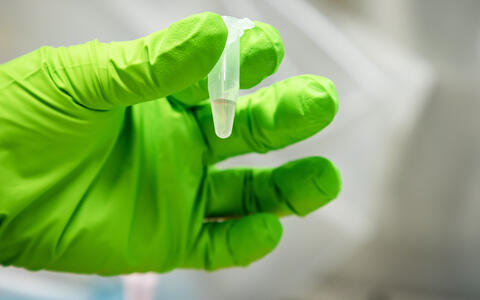Searching the sewers for viruses
SARS-CoV-2 is one of many pathogens that constantly reinvent themselves in an attempt to evade attacks from the human immune system. They do this by making tiny changes to their genetic material known as mutations. These mutations result in a new variant, which the body’s defense system is often less equipped to deal with than the pathogens it has already encountered – either through infection or vaccination.
All infections leave a trace
Wastewater samples arrive well-chilled at the MDC.
“This is why it is so important to detect newly emerging virus variants as quickly as possible,” explains Dr. Altuna Akalin, head of the Bioinformatics and Omics Data Science Platform at the Berlin Institute for Medical Systems Biology of the Max Delbrück Center (MDC-BIMSB). Together with Berlin’s water supply company Berliner Wasserbetriebe, the laboratory group amedes, and numerous other scientists at the Max Delbrück Center, Akalin developed a method to detect these variants in wastewater. Every single person who has been infected with a virus leaves traces of it in their waste – regardless of whether they develop symptoms, what those symptoms are, and whether or not they get tested.
The project included the participation of Professor Markus Landthaler’s RNA Biology and Posttranscriptional Regulation Lab, Professor Nikolaus Rajewsky’s Systems Biology of Gene Regulatory Elements Lab, and Dr. Janine Altmüller’s Genomics Platform. Akalin, Landthaler, and Rajewsky are joint last authors of the latest publication. Akalin’s team first presented the computer-assisted tool PiGx SARS-CoV-2 in December 2021 on the preprint server medRxiv. The first authors back then are the same for the latest study: Vic-Fabienne Schumann and Dr. Rafael Cuadrat from Akalin’s team, and Dr. Emanuel Wyler from Landthaler’s research group.
Faster than patient samples
The basic idea of the data analysis pipeline remains unchanged: “First, the genetic material of the viruses present in the wastewater must be sequenced, or decoded,” Akalin explains. The obtained data are then fed into the pipeline together with some additional information, such as on the sequencing method used. The resulting graphs allow both experts and non-experts alike to see current infection dynamics, as well as the variants that are circulating at different locations at the same time.
“Newly emerging variants can also be detected this way – and in most cases a few days sooner than would be possible with continuous testing and the sequencing of patient samples,” says Akalin. “Through our various collaborations, we have also been able to show that this sort of wastewater early warning system performs successfully under both scientific and industry conditions.” However, Akalin adds that the Max Delbrück Center does not carry out routine tests itself; it merely provides the method.
The pipeline works globally
In the future, additional tools will be integrated into the pipeline that will even enable us to predict the effects of a newly discovered mutation.
The tool, which has now been described in the journal “Science of the Total Environment”, has evolved further in recent months: “The algorithms we created have become even more robust,” says Akalin. “For example, we proved using data sets from New York that the pipeline can reliably analyze data from very different parts of the world – regardless of which sequencing protocol was used to obtain these data."
With their method, Akalin and his colleagues already discovered the COVID-19 Delta and Omicron variants before each became the dominant variant in the population. “Our software can track emerging mutations both spatially and temporally,” Akalin explains. “If more and more mutations begin to emerge in the wastewater of certain locations, these are flagged as potential new virus variants.”
“In the future, additional tools will be integrated into the pipeline that will even enable us to predict the effects of a newly discovered mutation,” adds Akalin. For example, he says, it will be possible to estimate how successfully new variants will be able to evade detection by the human immune system – and thus whether they will be more infectious or more serious than previous variants.
Flu viruses can also be tracked
“One of the most important characteristics of our system is that it is very robust and has a high degree of automation, so it can easily be used in large-scale wastewater monitoring,” says Akalin. But for now, his team wants to fine-tune the procedure for taking the wastewater samples: “Where and when you take a sample certainly seems to influence the data,” the scientist admits.
Wastewater sample before sequencing.
The common goal of all participating teams at the MDC-BIMSB is now to extend the approach beyond COVID-19 and establish a wastewater early warning system for emerging strains of influenza or noroviruses, for example – in other words, other pathogens that have a major impact on human health and thus also on economic productivity.
According to Akalin, there are companies emerging in the United States that already offer such services. So he thinks it is conceivable that this sort of monitoring strategy will be used regularly in the future in other parts of the world – and, he hopes, for tracking other pathogens too. Vaccine manufacturers could also benefit from the early warning system, which may enable them to adapt their vaccines to newly emerging variants more easily than before.
Text: Anke Brodmerkel
Further information
Literature
Vic-Fabienne Schumann, Rafael Ricardo de Castro Cuadrat, Emanuel Wyler et al. (2022): „COVID-19 infection dynamics revealed by SARS-CoV-2 wastewater sequencing analysis and deconvolution“, Science of the total environment, DOI: 10.1016/j.scitotenv.2022.158931
Photos to download
Wastewater samples arrived well-chilled at the MDC. Photo: Felix Petermann, MDC
The scientists filtered the brown broth, enriched the virus particles they found, and isolated and sequenced the virus’s genome. Photo: Felix Petermann, MDC
Wastewater sample before sequencing. Photo: Felix Petermann, MDC
Contacts
Dr. Altuna Akalin
Head of the Technology Platform “Bioinformatics and omics data science”
Max Delbrück Center
+49 30 9406-4271
Altuna.Akalin@mdc-berlin.de
Jana Schlütter
Editor, Communications Department
Max Delbrück Center
+49 30 9406-2121
jana.schluetter@mdc-berlin.de or presse@mdc-berlin.de
- Max Delbrück Center
-
The Max Delbrück Center for Molecular Medicine in the Helmholtz Association (Max Delbrück Center) is one of the world’s leading biomedical research institutions. Max Delbrück, a Berlin native, was a Nobel laureate and one of the founders of molecular biology. At the locations in Berlin-Buch and Mitte, researchers from some 70 countries study human biology – investigating the foundations of life from its most elementary building blocks to systems-wide mechanisms. By understanding what regulates or disrupts the dynamic equilibrium of a cell, an organ, or the entire body, we can prevent diseases, diagnose them earlier, and stop their progression with tailored therapies. Patients should be able to benefit as soon as possible from basic research discoveries. This is why the Max Delbrück Center supports spin-off creation and participates in collaborative networks. It works in close partnership with Charité – Universitätsmedizin Berlin in the jointly-run Experimental and Clinical Research Center (ECRC), the Berlin Institute of Health (BIH) at Charité, and the German Center for Cardiovascular Research (DZHK). Founded in 1992, the Max Delbrück Center today employs 1,800 people and is 90 percent funded by the German federal government and 10 percent by the State of Berlin.










